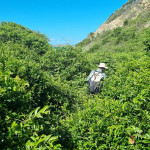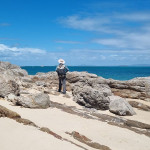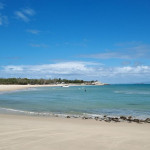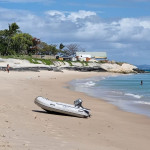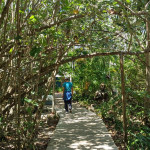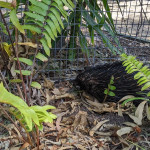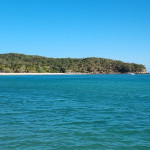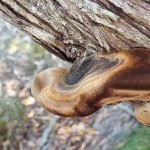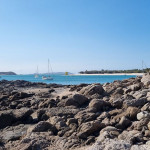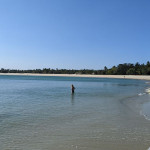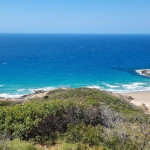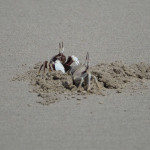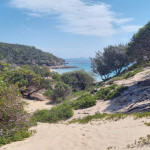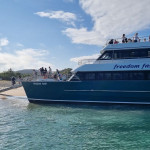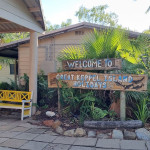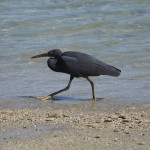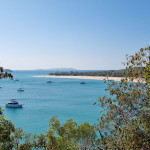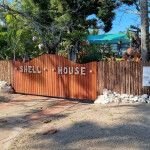Monday 4th September 2023
Today is our last day in the Whitsunday Islands. We enjoy a lovely morning at Maureen Cove, at the north of Hook Island. Maureen’s Cove is a renowned snorkelling site with easy access from the coral beach. It boasts an array of underwater valleys and caves, and abundant marine life including giant Maori Wrasse and Manta Rays, which unfortunately we didn’t see any of them.
After breakfast we head for a walk up the creek through a butterfly haven to a cave. This was walking through the dry creek bed over small rocks. As we continue it becomes bigger rocks and then boulder hopping and clambering. It was a fun and challenging walk. Along the way we saw a flutter of butterflies. As we disturbed them they all took off together and fluttered further up the dry creek bed. As always they were very difficult to capture. At the end of the creek we came to a small cave with many, many wasp nests inside. We then walked back again to the beach, as we were trying to squeeze as much in our day as possible. We packed up all our belongings and packed the kayak except for our snorkel gear. We then had a short snorkel out with a boat tour. They were a snorkelling a little bit further away in the deeper coral and having their support dinghy gave me a little more confidence to head over further from the beach. We saw some beautiful fish including some colourful parrotfish, a trumpet fish, many angel fish and a variety of other fish. We then headed back to shore to put the final touches on our packing and we were ready by 11.20am in time for a 11.30am-1.30pm pick-up.
We waited until about 1.15pm under the trees for the boat to arrive and then enjoyed a boat ride to Steen’s Beach, Crayfish Beach, then headed around the west side of the islands to South Molle and then back to Shute Harbour. We have had a fantastic adventure over the last five days, we have seen some amazing green sea turtles, an abundant variety of fish, coral and clams, met some lovely people, paddled through some amazing bays with incredible cliff-faces, rocky boulders and vegetation, plus the most fantastic crystal clear blue waters. What an amazing time we have had.
We have checked in to a cabin at the Tasman Tourist Park for 2 nights to recover, plan and reset ourselves for the next stage of our trip.
4L water today
-

-
David resting amongst the sawsedge at Maureens Cove camp on Hook Island..
-

-
..Early morning light at the beautiful calm bay of Maureen Cove..
-

-
..a Sooty Oyster Catcher..
-

-
..the Purple Crow Butterfly..
-

-
..as we walked up the creek the butterflies flew away in big numbers..
-

-
..a little rock-hopping..
-

-
..and bigger boulder clambering..
-

-
..all the way to the little cave at the end filled with wasp nests….
-
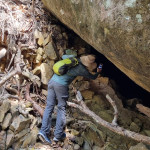
-
..David investigates closer to make sure he isn’t missing something..
-
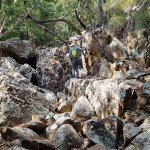
-
..and David continues along the rocky path..
-

-
..as I climb back down the boulders..
-

-
..back from our walk and it is time to get organised as we get picked up any time from 11.30am..
-

-
..this time we don’t have to pack everything in to the kayak, so our gear is all lined up ready to go..
-

-
..such a beautiful cove..
-

-
..the water was so clear..
-

-
..looking up the creek, there is still water in it at the beach..
-

-
..the angle of the shoreline was problematic for launching and landing at the beach..
-

-
..David is showing how steep it was for us to get the kayak fully loaded up the shore’s edge..
-

-
….as we watch Scamper coming in to collect us..
-

-
..looking back at Maureen Cove as we leave Hook Island..
-

-
..we collect others at Steens Beach..
-
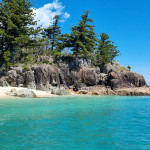
-
..which has the most beautiful coloured water and rocks..
-

-
..and again as we leave Steen’s Beach..
-

-
..as we head towards the mainland..
-

-
..and arrive back at Shute Harbour. The end of another great adventure with Broady Tours.














